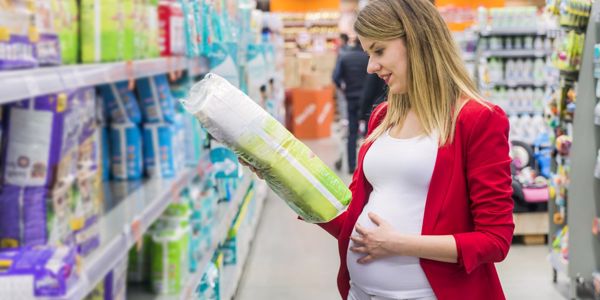Nappy rash is very common amongst babies and toddlers. Up to a third of all babies and toddlers can have nappy rash at any one time. It is not typical amongst newborns, but any baby can develop nappy rash whilst they wear nappies.
Nappy rash can be caused by anything that can irritate your baby’s sensitive skin. This can be:
- Your baby’s skin being in contact with their poo or wee for a long time
- The nappy rubbing against your baby’s skin
- Not cleaning the nappy area or changing the nappy often enough
- Soap, detergent or bubble bath
- Fragranced or alcohol-based wet wipes
- Your baby recently taking antibiotics
Nappy rash can be identified by red patches on your baby’s bottom, or the whole area could be red. Their skin will look sore and feel hot to the touch. There can also be raised pimples/spots/blisters like an allergy-type reaction on the skin. Babies with mild nappy rash won’t feel sore, but if it is severe, your baby will be in clear discomfort and distress.
[Read more: Hacks for Nappy Changing You Need to Know]
How to treat nappy rash
Preventing nappy rash is the key to treating it. Both the treatment and prevention methods are the same. You do not need any special prescribed cream or ointment from the doctor as it is very easily treated at home.
If the rash doesn’t cause your baby any upset, then you can apply a thin layer of a barrier cream such as Sudocrem or Savlon at each nappy change. Diprobase cream is also a great cream to help soothe irritated skin.
[Read more: Keeping Your Newborn's Skin Silky-Smooth]
Make sure you change wet or dirty nappies as soon as you know they’ve been soiled. Many nappy brands have colour indicators to help you know when this is. Clean the entire nappy area gently, wiping from front to back, NOT back to front. Use water wipes or fragrance-free, alcohol-free sensitive wipes to make sure there’s no further irritation.
You can also prevent nappy rash occurring by bathing your baby every day. Try not to bathe more often than that as it can dry out their skin. Try not to use soap, bubble bath or lotions when giving them a bath as these can irritate the skin. Avoid vigorous rubbing when drying them with a towel. Lay your baby on it first and leave their nappy off for as long as you can to let fresh air dry their skin before patting them dry with a soft towel. It is also a bad idea to use talcum powder following a bath as it contains ingredients that could irritate their skin.
By following these tips, your baby’s nappy rash should clear up after about 3 days. If the rash is causing your baby discomfort, contact your GP or health visitor as they can prescribe some medicated cream to help. If this happens, you should apply the medicated cream before a barrier cream and let it soak in before putting a new nappy on.
If your baby develops a rash in the nappy area that is a persistent bright red, moist rash with white or red pimples that spread to the folds of their skin, it is possible they could have an infection. If the rash is severe, take your baby to see your GP who can prescribe some treatment to help. It’s completely normal for your baby to develop rashes as their skin is so sensitive, but it’s very important to be able to distinguish the difference between a minor irritation like nappy rash, and a condition that requires attention.
[Read more: Reusable Nappies, Explained]






